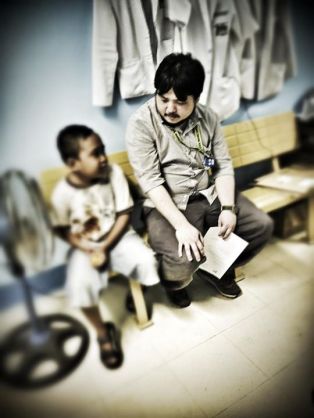I’ve always wanted to become a doctor. My formative years were greatly influenced by stories of the men in white and episodes of E.R. I was eager to experience my very own episodes of Grey’s Anatomy, complete with all the interesting cases, hospital drama, and emotional soundtrack playing in my head.
But that was then. Fast-forward to today, where I find myself working in a tertiary government hospital where, everyday, we are greeted with suboptimal working conditions and huge patient loads. Kayod kalabaw.
I must admit I have turned into a grouchy person who easily snaps and bears his fangs at the slightest provocation. You know. It’s hard to put on a smile at 3am when you have been awake for more than 24 hours, you’re so exhausted because you’ve been running around like a headless chicken, you haven’t studied for an exam that same morning, and you have an unfinished report due that very day. All you want is to be left alone with the work you have to do. Like in my chosen field where, most of the time, the longest meaningful relationship I’d want to have with a patient is just as long as the time it takes to complete his or her abdominal ultrasound exam.
But every now and then, we’d get reminders of exactly why we do the things we do.
His name is Darren, an eight-year old kid from Bicol. His friends and family fondly call him Kamote, a term or endearment lovingly given by his grandfather. A cute little name for a cute little man. It’s barely been a month since I began my rotation in Radiation Oncology, a section in our department that deals with cancer patients.
“Ilan taon ka na?” I asked.
“Eight po,” he answered back, trying to hold up his right arm and feebly attempting to extend eight tiny little fingers. He had difficulty extending his right elbow, likely one of the effects of surgery to his brain. He had been diagnosed with craniopharyngioma, a benign tumor that has a malignant behavior.
He talked about his home and current living conditions, parts of the medical ordeal he went through, and his love for TinTin, his childhood playmate. He thanked us for being mabait, with the utmost sincerity only a child can show – a gesture which struck me because he barely knew us. We had only met a few minutes ago.
“Anong naramdaman or inisip mo nung sinabi nila na ooperahan ka?” I asked.
“Natakot po,” Kamote replied. “Pero tinalo ko ang takot ko para sa mga magulang ko.” My heart started to break. He said that with a smile, his face glowing as if nothing happened. Only the surgical scar by the hairline at the left side of his forehead gave clue to what this kid went through. His spirit was inspiring and his inner strength, palpable.
And just like that, my weariness went away. That heavy felling you get on your shoulders and the dull pain you feel in your legs and feet at the end of a tiring workday just disappeared. In the face of sleepless nights, of inhuman physical and emotional demands, and of incommensurate payoffs, this is why we do it. Why Surgery residents go on duties 3 or 4 days straight, giving beyond what’s expected of them. Why Obstetricians dedicate their lives in bringing new life into this world. Why Pediatric residents lose sleep, pumping Ambu bags which help their patients breathe. Why oncology specialists strive to make the lives of their patients better. And why most doctors miss out on family occasions, rushing back to the hospital to attend to their patients in need. Ordinary people doing amazing things. Darren is an example of the little things that make it all worth it.
“Bakit po kayo nalulungkot?” he surprisingly asked.
“Huh?” I quipped.
“Eh kasi po, bakit po namumula ang mata niyo?”
“Ah wala, yung hangin lang yun. Yung electric fan kasi nakatapat sa mukha ko.” I answered. Kamote smiled.
To all my brothers and sisters who have answered the same calling, here’s to more kamote moments.
——————————————————————————————————-
About the author:
Toto Carandang, M.D. is a graduate of UERMMMC Medicine Class of 2003 and is currently pursuing post graduate training at UP PGH. Words and images are all Dr. Carandang’s.



